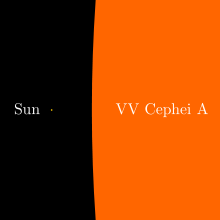VV Cephei
| Astrometry | |
|---|---|
| Absolute magnitude (MV) | -9 |
| Characteristics | |
| Spectral type | M2 Iab |
| Details | |
| Mass | 25-40 or 100 M☉ |
| Radius | 1600-1900 R☉ |
| Luminosity | 275,000-575,000(bolometric) L☉ |
| Temperature | 3300-3650 K |
VV Cephei is an eclipsing binary star system located in the constellation Cepheus. It contains a red supergiant which fills its Roche lobe when closest to its companion blue star, which appears to be on the main sequence; matter flows from the supergiant onto the blue companion. The stars are located about 3000 light years away from Earth.
VV Cephei A


VV Cephei A, the supergiant, is one of the largest stars known. It is of spectral type M2 and is about 1600–1900 times the Sun's diameter. If it replaced the Sun in our solar system, it would extend to the orbit of Saturn. It is 275,000-575,000 times as luminous as the Sun. The mass of the star is unknown. The mass estimated from its orbital motion is about 100 solar masses. On the other hand, the mass estimated from its luminosity is about 25-40 solar masses.
VV Cephei B
VV Cephei B, the blue main sequence star, is separated from the larger star by a distance of 25AU on average. And the distance is changing between 17 and 34 AU. It is a B0 star about 10 times the Sun's diameter and about 100,000 times its luminosity. The orbital period of the system is 7430 days (20.3 years). The eclipse lasts about 1300 days, and the midpoint of the last eclipse was in early January 1998.
